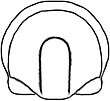Mallagnostus
Mallagnostus is an extinct genus from a well-known class of fossil marine arthropods, the trilobites. It lived during the upper Lower Cambrian, with remains found in USA (New York), Canada (Newfoundland), Spain, England, Russia (Tuva, Gorno-Altayskaya), Mongolia, and the lower Middle Cambrian according to fossils from China (Tian Shan) and Russia (Yakutia).[1]
| Mallagnostus | |
|---|---|
 | |
| Mallagnostus desideratus, cephalon | |
| Scientific classification | |
| Kingdom: | |
| Phylum: | |
| Class: | |
| Order: | |
| Family: | |
| Genus: | Mallagnostus Howell, 1935 |
| species | |
| |
| Synonyms | |
|
Ladadiscus Pokrovskaya, 1959 | |
Taxonomy
Mallagnostus was originally described as belonging to the Agnostina, but it is better placed in the Eodiscina. Within the Weymouthiidae, Mallagnostus belongs to a clade that further includes Tannudiscus, Jinghediscus and the Agnostina.[1]
Distribution
- M. limbatus has been collected from the upper Lower Cambrian of New York,[1] and the Toyonian of the Russian Federation (Obruchev stage, Shivelig Formation, Shivelig-Khem River, Tuva, Altay-Sayan, Siberia, 51.4° N, 94.2° E)[2]
- M. llarenai is found in the upper Lower Cambrian of Spain (serratus-Band, Herrerias-Mergel Formation, Cala).[1]
Ecology
M. limbatus occurs with Tannudiscus tannuolaicus, Menneraspis striata, Beldirella pulchra and Cheiruroides maslovi.[2]
Description
Like all Agnostida, Mallagnostus is diminutive and the headshield (or cephalon) and tailshield (or pygidium) are of approximately the same size (or isopygous) and outline. Like all Weymouthiidae, Mallagnostus lacks eyes and rupture lines (or sutures). The cephalon is semi-elliptical. The central raised area of the cephalon (or glabella) is unfurrowed (in one species there are indents in the lateral furrows). The glabella does not nearly reach the broad border furrow. The occipital ring (or L0) is short alont the axis, ill-defined, and it does not carry a spine. The anterior border of the cephalon is long, only gently convex, and becoming less deep further from the axis. The border furrow runs into the margin just in front of the genal angle. The thorax has three segments, like all other Weymouthiidae for which the thorax is known. The pygidium has the same shape as cephalon, with a conical axis of at least eight rings, and it does not reach posterior border furrow. The areas left and right of the axis (or pleural areas) are smooth.[1]
References
- Whittington, H. B. et al. Part O, Treatise on Invertebrate Paleontology. Revised, Volume 1 – Trilobita – Introduction, Order Agnostida, Order Redlichiida. 1997
- Osadchaya, D.V.; Kashina, L.N.; Zhuravleva, I.T.; Borodina, N.P. (1979). "Stratigrafiya i arkheotsiaty nizhnego kembriya Altaye-Sayanskoy skladchatoy oblasti [Lower Cambrian stratigraphy and archaeocyatha of the Altay-Sayan fold belt]". Trudy Instituta Geologii i Geofiziki, Sibirskoye Otdeleniye (380): 1–215. cited in Paleobiological Database. "Mallagnostus".